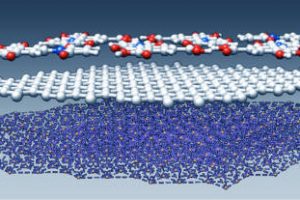While graphene has some amazing physical, optical and mechanical properties, its lack of a natural bandgap limits its use in electronics. Methods of varying complexity have been found to add bandgaps, and now there is another tool in the box – a chemical whose molecules self-assemble into an evenly-spaced flat lattice as they bond down into the graphene and give ...
Research
The latest electronics research news from within the industry and universities from around the world.
UK government backs 3D mapping Comet Interceptor probe
Thales Alenia Space have won the contract to design the mother ship for the Comet Interceptor mission, which will see one main spacecraft and two smaller robotic probes travel to an as-yet unidentified comet, and map it in three dimensions. The smaller probes (30cm in length) will be built by the Japanese Space Agency. For the mission, once in space, ...
Cathode deals with polysulphde shuttle in Li-S battery
Lithium sulphur cells can retain >95% Coulomb efficiency for 80 charge cycles at >300Wh/kg, according to the Hong Kong University of Science and Technology, which is working on a novel cathode design. The electrochemistry of lithium paired with sulphur (a low-cost material) make the combination desirable for lightweight high capacity batteries, but the elements, so far, are not happy bedfellows. “There ...
UKSA’s National Space Innovation Programme funds 21 UK organisations
The UK government is investing £7 million, via the National Space Innovation Programme, in 21 UK organisations working on innovative space technologies. The idea is that it represents cash injections for “high-risk, high-reward” projects of both companies and universities. Areas addressed include monitoring climate change through Earth Observation and satellite communications to provide greater connectivity to remote places. For example, one ...
400W wireless charger tracks moving receiver with maximum efficiency
Multiple transmit coils can ease positional constraints in wireless charging systems, but it is not easy to optimise power transfer. Now Korean engineers have found an elegant way to do it, only measuring the reflected receiver impedance from each transmit coil and processing that to decide how much current each transmitter should deliver. “Our strategy breaks away from the more traditional ...
Imec to demo application of photolith to organic semiconductors
Later this week, Imec is showing how photolithography can be used to pattern organic semiconductors and the cathode in an OLED-display stack which has the potential to eliminate the use of fine metal masks (FMM). The demonstration is important for display manufacturers as photolithography enables higher resolutions, or an increased transparency of the cathode, to accommodate for display-integrated sensors. Imec ...
Working towards a sensor to monitor healing in chronic wounds
A flexible wearable sensor might one day guide treatment for chronic (long-lasting) wounds such as diabetic foot ulcers or pressure ulcers. Researchers from Russian institute Skoltech and the University of Texas at Austin have created a prototype for such a sensor, and demonstrated it in a simulate wound environment where it measured three biomarkers, all of which are electro-active: Pyocyanin, produced a ...
AI is too powerful for engineers to handle alone
AI is too powerful for engineers to handle alone, is one of the conclusions of a study into autonomous systems and humanity people by the University of Texas at Austin. Instead, future designs must be guided by a broad range of societal stakeholders. Over 100 US autonomy experts were involved, whose work has been pulled together in a report (see below), commissioned ...
Graphene makes better heat pipes
Graphene can make heat pipes work much better, according to Chalmers University of Technology in Sweden. Heat pipes, often seen in high-end PCs, are sealed hollow tubes that contain a liquid at a pressure than ensures part of it is vapour at the temperatures of interest. If you put one end of a heat pipe in a hot place and ...
Harwell to host 5G/satellite engineering hub
An engineering hub for 5G and satellite technologies is to be built by the IT and business consultancy CGI at the Harwell Campus in Oxfordshire. The hub is backed by over £3 million of Government investment and due for completion in 2021. The centre is being backed by a European Space Agency contract, and as part of the development CGI ...
 Electronics Weekly Electronics Design & Components Tech News
Electronics Weekly Electronics Design & Components Tech News









